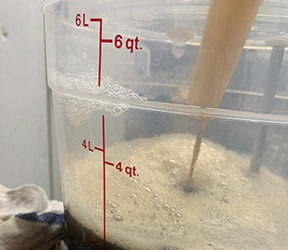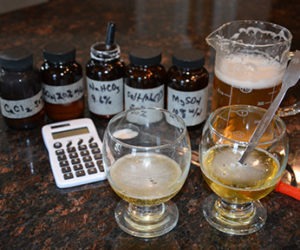Lautering Efficency
All-grain brewers are always talking about brewing efficiency — how much wort they yield from their mash into the boil kettle. There are two components to brewing efficiency: mashing efficiency and lautering efficiency. Mashing efficiency is all about the conversion of malt starches to sugars. Lautering efficiency is all about the extraction of those sugars to the kettle. There are several factors that determine lautering efficiency, but they all boil down to uniformity of flow.
No and batch sparging
At 75% yield (total extract), the first wort gravity is about SG 1.075–1.085 for the typical grist ratios that homebrewers use (1.3–1.5 qts./lb. or 2.7–3.1 L/kg). So, what is the best way to extract that typical 75% yield? The answer depends on your equipment and patience. The simplest way is to just drain it — and this is called no-sparge brewing. However, with no-sparge brewing, a proportion of the wort will be left behind in the wet grain and your wort pickup tube. To recover this extract, you will need to add more water to the mash, stir and drain it again. This is called batch sparging. Each time you fill the mash and drain the wort, you dilute the remaining extract in the grainbed and leave behind a proportion of that extract, diluted to the new concentration. (Just like re-using a teabag.) The efficiency of batch sparging is best when the volumes of the first and second runnings are equal, i.e., half of your desired boil volume. A single batch sparge in this manner should obtain most of the available extract (roughly 90%). If three runnings are collected, all at the same volume, the efficiency should improve by about 5%.
Batch sparging is nice because it is simply draining, nothing fancy about it, provided your grainbed has good permeability. A finely-crushed grist will convert very well and give a high yield, but it will lauter very slowly. Your grainbed permeability will affect your lautering capability, no matter what sparging method you use.
Draining vs. rinsing
If you batch sparge, and fill the grainbed again, you dilute the sugars to a new concentration. The amount of sugar that comes out of the grain is a function of the concentration gradient between the solvent (water) and the solute. As the difference in concentration diminishes, the extraction of the sugar from the grainbed diminishes. The way to increase the extraction rate is to keep the concentration gradient high, by constantly presenting water to the grain. Continuous or ”fly” sparging is a rinsing process that works in this manner. The challenge with continuous sparging is making sure that all the grain is equally rinsed.
The key to effective rinsing is uniform flow throughout the grainbed. The key to uniform flow is to maintain a steady state. The inflow should equal the outflow, and the permeability of the grainbed should be uniform so that water does not flow more easily through one side of the grainbed than the other. The inflow of water to the grainbed should be uniform across the surface area, and the easiest way to accomplish that is to maintain an inch (2.5 cm) or so of free water above the grainbed. Likewise, the outflow should occur uniformly across the grainbed area, otherwise the flow through the bed will vector toward the drain, leaving outlying areas unrinsed. A single collection point causes the most vectoring under steady state conditions and this behavior is shown in Figure 1.
Increasing the number of collection points reduces the amount of vectoring, and increases the uniformity of rinsing, as shown in Figure 2.
Fluid mechanics gives us the science to quantify this effect, and we can build histograms of the relative amounts of flow occurring in the grainbed. These results are shown in Figures 3 and 4.

A computer model was constructed assuming an 8-inch (20-cm) deep by 10-inch (25 cm) wide grainbed, and while that may seem small, it reduced the computation time, and the results are applicable to any size grainbed. The model calculated about 56% of the flow would be uniform for a single pipe manifold, and about 80% for a 2 pipe configuration. Increasing the coverage to 4 pipes improves the uniformity even further to 92%. The upper limit is found with a false bottom configuration. Its histogram is shown in Figure 5, and the uniformity is nearly 97%.

If you consider that the amount of extract in the grain is finite (i.e., once it’s gone, it’s gone) then we can estimate the efficiency of a lautering system by assuming that the percentage of extract from a region is equal to the proportion of flow that the region experiences, up to 100%. In other words, a 70% flow region will yield 70% of its total extract, and a 110% flow region will yield 100% of its extract. The model predicted about 92% of the volume lautered for a single pipe manifold, and about 96% for a 2 pipe configuration. Increasing the coverage to 4 pipes improves the efficiency to nearly 99%, almost equal to that of a false bottom at 99.7%.
The arrangement of the collection system is a big factor in flow uniformity. The examples above show that uniformity and efficiency improve with more pipes, but it’s the arrangement and spacing of the pipes that make the difference. Uniformity is highest when the outflow area (floor of the lauter tun) is evenly divided by the pipes and when the pipe spacing is as close as possible. Imagine that the bottom of the lauter tun is 12 inches wide. Three pipes could be placed across the tun at 0, 6, and 12 inches, and that evenly divides the area (uniformity = 80%). But the flow convergence is reduced and uniformity optimized when the 3 pipes are moved closer together, and placed at 2, 6, and 10 inches (uniformity = 89%). This balanced spacing arrangement increases the number of equal areas from 2 to 3 (actually 2 plus 2 halves).
The same principle applies to round tuns, like a Sankey keg or Gott cooler. A single ring manifold works very well when it is sized to a diameter that divides the circular volume in half, and that equation is ring dia. = 0.707 x tun dia. It is interesting to note that the uniformity and efficiency of a false bottom does not surpass that of a single ring manifold until the false bottom diameter is greater than 80% of the tun diameter.
The final factor to be considered in lautering (continuous or batch) is the flow rate. There are two reasons to run the lauter slowly. No matter what method or collection system you use, you need to start the flow slowly or you will tend to compact the grainbed around the device and impede flow. You want the main resistance to flow to be at the collection points (the holes/slots in the false bottom or pipes), not in the grainbed. If the resistance to flow is greater in the grainbed than in the collection system, the grainbed will compact and you will have a stuck sparge. This is especially true for false bottom systems. Second, when continuous sparging, you need to consider that rinsing involves diffusion and transportation of the sugar out of the wet grain. It takes a certain amount of time for this to occur and if your flow rate is too fast, you will simply run water thru the tun and fill your boil kettle with water and not extract.
Not surprisingly, lauter tun design has been studied extensively by commercial brewers. In commercial lauter tuns, the rule of thumb is 1 to 1.5 outlets per square meter of lauter area and the flow velocity through the outlet should be very slow, about 0.1 meters per second, to prevent significant “pull” at the drain. (On a homebrew scale, one outlet is more than sufficient for a false bottom and wort is usually collected at the rate of approximately one quart (~1 L) per minute.) In commercial designs, lauter tuns usually have flat bottoms and the false bottoms cover the whole bottom. Homebrew solutions involving pipes or other manifolds inserted in coolers or kegs are less efficient than false bottoms. Their efficiency improves as the number and spacing of outlets approaches that of a false bottom — and pipe manifolds or other homebrew gadgets can certainly deliver an acceptable level of performance.
If high lautering efficiency is your primary goal, continuously sparging your grain bed at a slow, steady rate in a lauter tun with a false bottom would be your best option.





